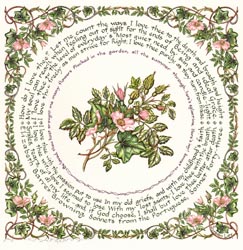
Poetry Selections - "HOW DO I LOVE THEE?"
How do I love thee? Let me count the ways.
One of the world's favorite romantic poems is accompanied by delicate flowers and ivy that represent poetic love and fidelity in the language of flowers.
The calligraphed poem, Sonnet 43, from the poet's romantic Sonnets from the Portuguese, was written during her courtship with Robert Browning. Susan Loy chose sweet briar rose buds (eglantine) to mix with the deep green of ivy. In the language of flowers, eglantine is the flower of love and poetry while ivy represents marriage and fidelity. Perfect Wedding and Anniversary Gift.
Elizabeth Barrett was an established poet when she met Robert Browning in 1845, whom she married in 1846 over her fatherís objections. They went to Italy and lived there until her death in 1861. Their life together is considered an example of perfect companionship. They were separated from each other only when Elizabeth died, cradled in Robertís arms. He never completely recovered from the shock.
Sweet briar or eglantine (Rosa rubiginosa) has represented poetry and love since at least Chaucerís time. The flowers are a soft pink color and both the leaves and blossoms have a sweet, spicy scent. The meaning of ivy for fidelity is because it is not able to support itself, but depends on tree and walls up which to climb. But once it has gained hold, nothing can separate it. It does not live off its partner, but feeds off its own roots.
"How Do I Love Thee?" Elizabeth Barrett Browning, print by Susan Loy
Image size 9-1/2"x9-1/2"
Gift wrap available. Please specify occasion.

I love thee to the depth and breadth and height
My soul can reach, when feeling out of sight
For the ends of Being and ideal Grace.
I love thee to the level of everyday's
Most quiet need, by sun and candle-light
I love thee freely, as men strive for Right;
I love thee purely, as they turn from Praise.
I love thee with a passion put to use
In my old griefs, and with my childhood's faith.
I love thee with a love I seemed to lose
With my lost saints, - I love thee with the breath,
Smiles, tears, of all my life! - and, if God choose,
I shall but love thee better after death.
Edition limited to 3,000 signed & numbered prints from Susan Loyís original watercolor.
Paper size: 11-1/2"x11"
Frame size: 16"x16"
Read the COMPLETE TEXT for "How Do I Love Thee?"
Are you ready to make a purchase? You can...

Use our SEARCH ENGINE if you are you looking for a Literary Calligraphy painting with a specific word or phrase!
Return to complete Online Catalog
Show Schedule | New Items | Request Color Print Catalog
Contact Us | Frequently Asked Questions | Home
